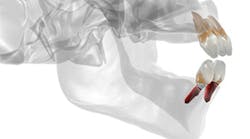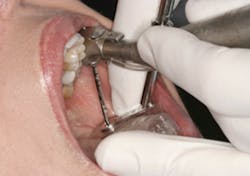As a dentist involved in social media, I get to see a lot of opinions on dental implants and guided implant surgery. There are those who embrace new concepts and those who resist. As a dentist who places implants every day in my practice, I can say that, with the proper training, guided surgery provides a solution where doctors can plan an implant virtually, and then accurately place an implant in the most safe, predictable, and efficient manner. With guided surgery, not only can we place the implant for the most esthetic result, but we can also superimpose abutments and predict how much room will be needed for the crown and for any veneered suprastructure that may go over the abutment.
To do guided implant surgery you need three things: a patient with an edentulous area, a cone beam scan with or without a radiographic guide, and a model -- either stone or virtual -- on which the surgical guide will be made. The first step is to do a thorough oral and medical exam to be certain that the patient is not only a candidate for guided implants, but for implants in general. In some cases, a removable appliance or bridge may be the best restoration for what the patient needs. With some systems, the length of the drills, guides, handles, and handpieces may be too large for a patient with a limited opening. (Fig. 1) You must be certain that the patient is scanned by a system that works with the implant planning software you are using and the lab that will ultimately fabricate the guide.
The number one reason that I place implants via guided surgery is safety. The surgical guide may rest on the teeth, gingiva, or bone. The Sirona Surgical Guide has stops that limit the depth of the drill and limit the depth of the implant. All guesswork is eliminated with the Surgical Guide. A position statement from the American Academy of Oral and Maxillofacial Radiology states, "The AAOMR recommends that cross-sectional imaging be used for the assessment of all dental implant sites and that CBCT is the imaging method of choice for gaining this information." A standard periapical radiograph is a 2-D representation of a 3-D object. Valuable images of nerves, sinuses, and other anatomic landmarks get superimposed upon one another in a 2-D image. The mesiodistal width of bone can be somewhat accurately assessed in a 2-D film, but that is just one piece of a larger puzzle. In the cross-sectional image, we can see where nerves lie, where the submandibular fossa is, the accurate width of the implant required, the optimal placement of the implant platform relative to the bony crest, the approximation of where the implant screw access will be relative to the proposed restoration, and finally, the density of the bone. (Fig. 2) For those who don't normally use 3-D imaging, why would you not want to know this?
The second reason that I do the majority of my implants via guided surgery is predictability. Patients look to us as a strange combination of clinician, therapist, and fortune teller! We have to somehow assess what patients want clinically, how they would feel about getting their teeth back, and how they will look, exactly. Without adequately assessing how much teeth, gingiva, and bone they have lost, it's anyone's guess. I make it a point to personally sit down with all patients who are getting implants and go over their CBCT scans. I discuss the limitations of their biology and make them own up to their problems. If they do not have adequate bone, I can show them in 3-D! I can then let them know if it is even possible to give them the end result they expect. It may be a crown in the esthetic zone that, due to bone loss, may not be the same size as its neighbors. In that case, I would discuss grafting. If it is an edentulous case, the scan and the planned implants would give me the information to tell my patients whether they could have a fixed or a removable appliance. I can do a wax-up or have software give me virtual teeth to show the patient the end result. I am able to accurately predict for my patients the outcome of their implant treatment by showing them the CBCT scans with virtual implants and teeth, the results of their oral and medical exams, and any model work.
Finally, I place my implants via guided surgery because it is so efficient. My first implant in my practice was like going to the prom! I must have planned that supereasy implant on No. 19 for two months. I could not sleep the night before. The distance from the crest to the nerve was 26 mm (a normal length of a long implant drill is 22 mm), so there was really almost no risk. The procedure took me two hours, and would now take me about 10 minutes. I thought to myself, "There is no way I could efficiently incorporate this into my practice." With guided surgery, all the planning and "back and forth" with drilling, angulation, and depth is all figured out before the patient appears for surgery. Most guided implant surgeries are completed in less than 20 minutes in my office for single teeth, with enough attached tissue for a punch. A full arch of implants may take me less than an hour. If one follows some pretty easy-to-master protocols, this is the norm from a lot of reputable doctors I talk to.
Change is always hard. The older I get, the less tolerant I am with learning curves. But technology keeps forging on. The real key with any technology is to get beyond the hype and see how you can incorporate it into your day-to-day life. I can't tell you how many gadgets and gizmos have ended up in the "Closet of Shame" in my office. I can tell you from practical experience that the CBCT scanners, CAD/CAM systems, and implants in the general dentist's office are not only here to stay, but will soon become the standard of care in your practice.
August de Oliveira, DDS, practices full-time in Los Angeles. He has written two books on implantology. He lectures nationwide for Sirona on the Galileos cone beam system and guided implant surgery and for Implant Direct at its Las Vegas facility. He can be reached by email at [email protected]. Ryan C. Maher, DMD, FICOI, studied implants at the California Implant Institute and the Southwest Implant Institute. He was awarded a fellowship with the International Congress of Oral Implantologists. You may reach Dr. Maher by email at [email protected].
Past DE Issues








